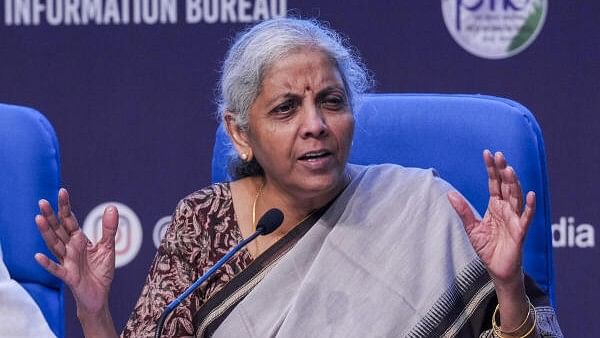
Union Finance Minister Nirmala Sitharaman addresses a post-Budget press conference in New Delhi on Tuesday, July 23, 2024.
Credit: PTI Photo
New Delhi: Prime Minister Narendra Modi’s government on Tuesday proposed to allocate Rs 86000 crore for implementing the rural job scheme in 2024-25, even as the Economic Survey noted that the demand for employment under the programme was not directly correlated to increased distress in the villages.
As Finance Minister Nirmala Sitharaman presented the Union Budget 2024-25 in the Lok Sabha just one-and-a-half months after the ruling Bharatiya Janata Party failed to reach its “aab-ki-baar-400-paar” target in the parliamentary elections, she proposed to earmark Rs 2.66 lakh crore for rural development, including for building infrastructure, in an obvious attempt to regain the saffron party’s support bases in the villages.
She proposed to raise the allocation for the Ministry of Rural Development from Rs 159,964.23 crore in 2023-24 budget estimates to Rs 180,233.43 crore in 2024-25.
“(The) Phase IV of (the) PMGSY (Pradhan Mantri Gram Sadak Yojana) will be launched to provide all-weather connectivity to 25,000 rural habitations, which have become eligible in view of their population increase,” Sitharaman said, presenting the Union Budget. She proposed to allocate Rs 16100 crore for the PMGSY in 2024-25, keeping it at the same level as the 2023-24 budget estimates.
The government reversed the trend of the past few years of slashing funds for the Mahatma Gandhi National Rural Employment Guarantee Scheme. It instead proposed to raise the allocation for the programme in 2024-25 by around 43%.
The Union Budget earmarked Rs 86000 crore for the implementation of the MGNREGS in 2024-25, raising it by Rs 26000 crore from the allocation of Rs 60000 crore in the previous financial year. The Revised Estimate for the scheme in 2023-24 had gone up to Rs 86000 crore. The finance minister proposed to keep the allocation for the scheme for the coming financial year at the same level as the revised estimate of the current year.
The interim budget presented just before the Lok Sabha elections had also proposed to allocate Rs 86000 crore for the MGNREGS, less than the actual expenditure of Rs 90805 crore in 2022-23.
The All-India Kisan Sabha – the peasants organisation of the Communist Party of India – criticised the government for not raising the allocation for the MGNREGS, pointing it out that almost Rs 42000 crore earmarked for the scheme had already been spent, leaving only Rs 44000 crore for implementing it during the rest of the financial year.
The MGNREGS – mandated by the Mahatma Gandhi National Rural Employment Guarantee Act – is a demand-driven programme designed to guarantee at least 100 days of wage employment in a financial year to every rural household having adults ready to do unskilled manual work. The scheme was launched on February 2, 2006, and was often highlighted by the erstwhile United Progressive Alliance (UPA) government as a programme that legally guaranteed minimum livelihood security to the rural population, contributed to bringing up rural wages, lessened distress migration, and empowered weaker sections.
The scheme had provided a safety net for the rural population during the pandemic, compensating for up to 80% of income loss caused by shutdowns imposed to contain the Covid-19 pandemic. The actual expenditure for the scheme in 2020-21 and 2021-22 had stood at Rs 1.11 lakh crore and Rs 98467.85 crore respectively.
The BJP-led government had drawn flak when it had slashed allocation for the scheme for the 2023-24 to Rs 60000 crore.
The Economic Survey, presented in Lok Sabha on Monday, noted that while some reports suggested that the MGNREGS demand was indicative of rural distress, insights from implementation of the scheme in 2023-24 showed that although Tamil Nadu had less than 1% of the country's poor population, it had accounted for nearly 15% of all MGNREGS funds released. Similarly, Kerala, with only 0.1% of the poor population, used almost 4% of the funds earmarked for the scheme.
In contrast, Bihar and Uttar Pradesh, with about 45% (20% and 25% respectively) of the poor population, accounted for only 17% – 6 and 11% percent respectively – of the MGNREGS funds, the Economic Survey noted.
Sitharaman on Tuesday proposed to raise the allocation for the Pradhan Mantri Awas Yojana (Grameen) from Rs 50,486.99 crore in the 2023-24 Budget Estimate to Rs 54,500.13 crore for the current financial year. Against the target of building 2.95 crore houses in the villages under the PMAY (Grameen). 2.94 crore houses were sanctioned by the Ministry of Rural Development, and 2.62 crore houses were constructed till the middle of the last month.
Soon after Modi commenced his third term in the office of the prime minister, the BJP-led coalition government decided to sanction the construction of 3 crore more houses under the PMAY scheme, not only in the rural areas but also in the urban areas.
Union Budget 2024 LIVE | Making a record for any Finance Minister, Nirmala Sitharaman presented her 7th consecutive Union Budget on July 23, 2024 under the Modi 3.0 government. This Budget brought tax relief for the middle class, while focusing on jobs through skilling, incentivising employers. Track the latest coverage, live news, in-depth opinions, and analysis only on Deccan Herald. Also follow us on WhatsApp, LinkedIn, X, Facebook, YouTube, and Instagram.
